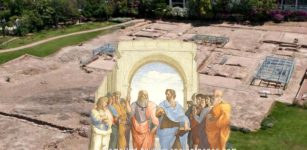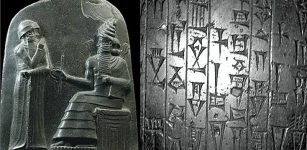Enigmatic Dispilio Tablet, Neolithic Flutes And The Traditional History Of Writing
A. Sutherland - AncientPages.com - This wooden tablet known as the Dispilio Tablet (or the Dispilio Disk), contradicts history as we know it.
If it is proved one day, the beginning of writing goes back at least two thousand years.
The curious wooden tablet was unearthed during the 1992 excavations conducted by the professor of prehistoric archaeology George Chourmouziadis and his team at the Aristotle University of Thessaloniki. The place of this fascinating discovery was the Neolithic settlement near the modern village of Dispilio on Lake Kastoria in Northern Greece.
The excavations yielded findings like bones, four different types of ceramic material were unearthed. These vessels were associated with food preparation (cooking utensils) and the offering and consumption of food.
Archaeologists also unearthed various artifacts, including ornamental items, figurines, decorative motifs adorning vessels, and certain specialized vessel types whose intended purpose remains elusive. Other finds included four objects composed of bone and clay, presumably utilized for producing sound (melody?)
Additionally, the team found a limited assemblage of funerary objects, as well as two additional child burials unearthed at an approximate depth of 80 centimeters and a collection of human bones.
As for the puzzling wooden tablet, it is covered with inscribed horizontal and vertical markings, some of which bear resemblance to the symbols of Linear A writing. This artifact is considered the most important find.
Do inscriptions on a wooden tablet represent the earliest communication effort in Southeastern Europe? Was it an early form of written speech of our ancestors?
The artifact - inscribed with symbols similar to those of the Vinca Culture - has been carbon 14-dated to about 5260 BC, which means that it is 2,000 years older than proto-Sumerian pictographic script from Uruk (modern Iraq) and 4,000 years older than the Cretan-Mycenean linear types of writing.
According to Professor Chourmouziadis, the text with the markings could not be quickly published because it would ultimately change the current historical background concerning the origins of writing and articulate speech depicted with letters instead of ideograms within the borders of the ancient Greek world and, by extension, the broader European one.
The current theory proposes that the ancient Greeks received their alphabet from the ancient civilizations of the Middle East (Babylonians, Sumerians, and Phoenicians). Thus, it fails to close the historic gap of some 4,000 years.
This gap translates into the following facts: while ancient eastern civilizations would use ideograms to express themselves, the ancient Greeks were similarly using syllables like we use today, according to Chourmouziadis.
The currently accepted theory suggests that the ancient Greeks learned to write around 800 BC from the Phoenicians.
Among the many important questions that emerge among scholars are:
The text of the Dispilio tablet. (Original text: c. 5300 BC). The marks on the tablet of Dispilio (column on the left) and similar signs in other ancient scriptures (remaining three columns). Image credit: Unknown author - Public Domain
- How can the Greek language have 800,000-word entries, ranking first among all known languages worldwide, while the second next has only 250,000-word entries?
- How could the Homeric Poems have been produced at about 800 BC, when the ancient Greeks first learned to write?
According to US linguistic research, the ancient Greeks could only have written these poetic works with a writing history dating back at least 10,000 years. Chourmouziadis, on the other hand, said that the markings on the tablet did not resemble the human figures, the sun and moon, or other figures ideograms usually depict.
Dispilio is the only excavated Neolithic lakeside settlement in Greece. Archaeological research showed that the site was continuously used from the Early Neolithic (about 6000 BC) to the Late Chalcolithic period (about 1200 BC, Mycenaean period).
Excavations revealed a portion of the settlement with the architectural layout of homes, the building materials, fragments of pottery, stone and bone tools, clay figurines (both anthropomorphic and zoomorphic), miniature representations of objects also on clay, animal and fish bones, and charred fruits and grains.
These findings contributed information on the everyday lives of the Neolithic inhabitants of the area. A series of charcoal and wood samples were radiocarbon dated to about 5470 to 4850 BC.
The most unexpected of the finds, a wooden tablet from the lake bearing engraved symbols, was 14 C dated to 5260 ± 40 BC. In addition, clay tablets and pottery vessels engraved with similar symbols were also unearthed from layers dated to the same period.
Written by – A. Sutherland - AncientPages.com Senior Staff Writer
First version of this article was published on Oct 28, 2014
Copyright © AncientPages.com All rights reserved. This material may not be published, broadcast, rewritten or redistributed in whole or part without the express written permission of AncientPages.com
Expand for referencesReferences:
Kokkinidou, Dimitra, and Katerina Trantalidou. “Neolithic and Bronze Age Settlement in Western Macedonia.” The Annual of the British School at Athens 86 (1991): 93–106.
IFANTIDIS, FOTIS. “Archaeographies: EXCAVATING NEOLITHIC DISPILIO.” In Archæographies: Excavating Neolithic Dispilio.
More From Ancient Pages
-
 Men Are Slowly Losing Their Y Chromosome – Is The Future Of Humanity In Danger?
Featured Stories | Nov 7, 2023
Men Are Slowly Losing Their Y Chromosome – Is The Future Of Humanity In Danger?
Featured Stories | Nov 7, 2023 -
 Fall Equinox Explains Unusual Alignment Of Egypt’s Great Pyramids – Engineer Says
Archaeology | Feb 26, 2018
Fall Equinox Explains Unusual Alignment Of Egypt’s Great Pyramids – Engineer Says
Archaeology | Feb 26, 2018 -
 A Glimpse Into The Past – Sights And Sounds Of St. Paul’s Cathedral Recreated
Archaeology | Oct 8, 2021
A Glimpse Into The Past – Sights And Sounds Of St. Paul’s Cathedral Recreated
Archaeology | Oct 8, 2021 -
 Millennia Old Extremely Complex Object Of Unknown Origin
Ancient Technology | Jul 8, 2020
Millennia Old Extremely Complex Object Of Unknown Origin
Ancient Technology | Jul 8, 2020 -
 How Did Alexander The Great Die?
Featured Stories | Apr 9, 2016
How Did Alexander The Great Die?
Featured Stories | Apr 9, 2016 -
 Mystery Of An Edinburgh Crypt – Secrets Of Warriors Of Dark Ages In Scotland – Revealed
Archaeology | Oct 3, 2015
Mystery Of An Edinburgh Crypt – Secrets Of Warriors Of Dark Ages In Scotland – Revealed
Archaeology | Oct 3, 2015 -
 Aristotelian Thought Is Being Revived In Lyceum – Ancient School Founded By The Greek Philosopher
News | Jan 30, 2023
Aristotelian Thought Is Being Revived In Lyceum – Ancient School Founded By The Greek Philosopher
News | Jan 30, 2023 -
 Runic Inscription On The Forsa Ring Is Not What We First Thought – Scientists Say
Archaeology | Aug 15, 2024
Runic Inscription On The Forsa Ring Is Not What We First Thought – Scientists Say
Archaeology | Aug 15, 2024 -
 Evidence People Lived In Australian Desert 50,000 Years Earlier Than Previously Thought
Archaeology | Sep 22, 2018
Evidence People Lived In Australian Desert 50,000 Years Earlier Than Previously Thought
Archaeology | Sep 22, 2018 -
 Is The Poverty Point Octagon World’s Largest Ancient Solstice Marker?
Featured Stories | May 21, 2017
Is The Poverty Point Octagon World’s Largest Ancient Solstice Marker?
Featured Stories | May 21, 2017 -
 Mystery Of Zendan-e Eskandar – Alexander The Great’s Prison
Featured Stories | Oct 14, 2020
Mystery Of Zendan-e Eskandar – Alexander The Great’s Prison
Featured Stories | Oct 14, 2020 -
 Hammurabi: The Great King Of Babylon And His Laws
Civilizations | Oct 21, 2016
Hammurabi: The Great King Of Babylon And His Laws
Civilizations | Oct 21, 2016 -
 Shepherd’s Graffiti Sheds New Light On Acropolis Lost Temple Mystery – New Research
Featured Stories | Jun 17, 2024
Shepherd’s Graffiti Sheds New Light On Acropolis Lost Temple Mystery – New Research
Featured Stories | Jun 17, 2024 -
 Isabel Neville And Unsolved Mystery Of Her Death
Featured Stories | Mar 28, 2019
Isabel Neville And Unsolved Mystery Of Her Death
Featured Stories | Mar 28, 2019 -
 Ancient Secrets Of Mankind And The Anunnaki Revealed On The 14 Tablets of Enki
News | Jun 18, 2014
Ancient Secrets Of Mankind And The Anunnaki Revealed On The 14 Tablets of Enki
News | Jun 18, 2014 -
 On This Day In History: Terracotta Army Buried With Emperor Qin Shi Huang Discovered – On Mar 29, 1974
News | Mar 29, 2017
On This Day In History: Terracotta Army Buried With Emperor Qin Shi Huang Discovered – On Mar 29, 1974
News | Mar 29, 2017 -
 Incredible Ancient Star Map Depicting Our Galaxy Is Hidden In Africa
Featured Stories | Aug 4, 2018
Incredible Ancient Star Map Depicting Our Galaxy Is Hidden In Africa
Featured Stories | Aug 4, 2018 -
 Beginning Of Fashion – Paleolithic Eyed Needles And Evolution Of Dress
Archaeology | Jun 29, 2024
Beginning Of Fashion – Paleolithic Eyed Needles And Evolution Of Dress
Archaeology | Jun 29, 2024 -
 Björketorp Runestone With Frightening Message Is Still Untouched In Blekinge, Sweden
Featured Stories | Mar 19, 2023
Björketorp Runestone With Frightening Message Is Still Untouched In Blekinge, Sweden
Featured Stories | Mar 19, 2023 -
 Wreckage From Famous Warships Explored In 3D On Anniversary Of Sinking
Archaeology | Nov 22, 2022
Wreckage From Famous Warships Explored In 3D On Anniversary Of Sinking
Archaeology | Nov 22, 2022



